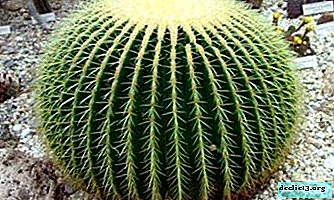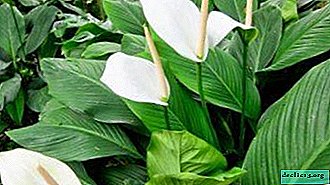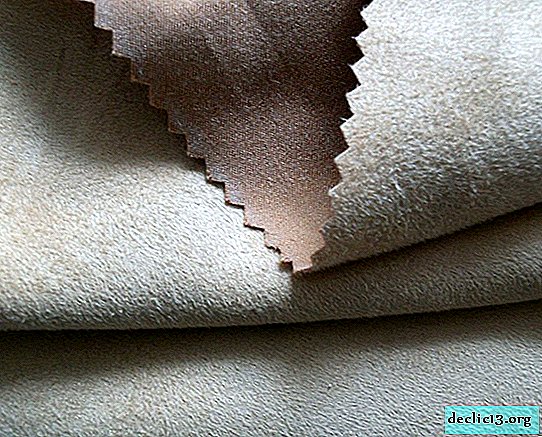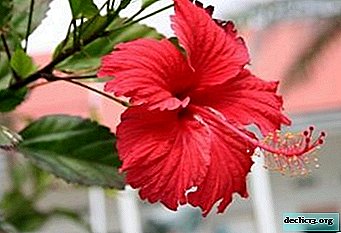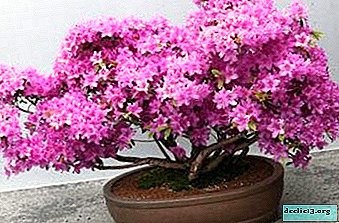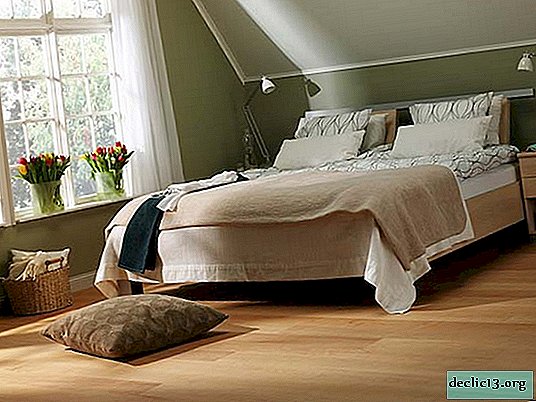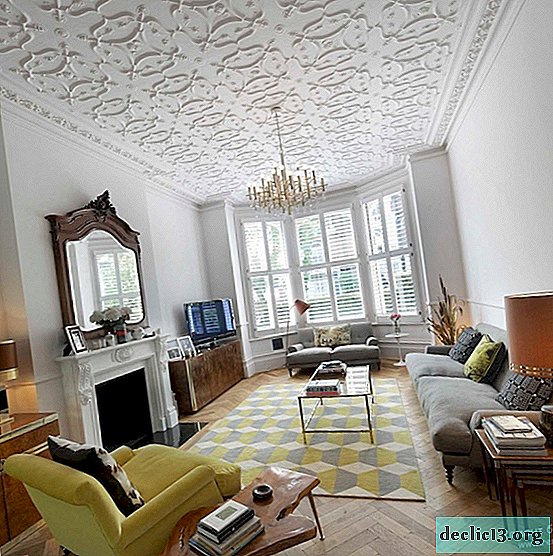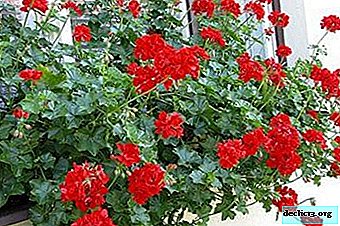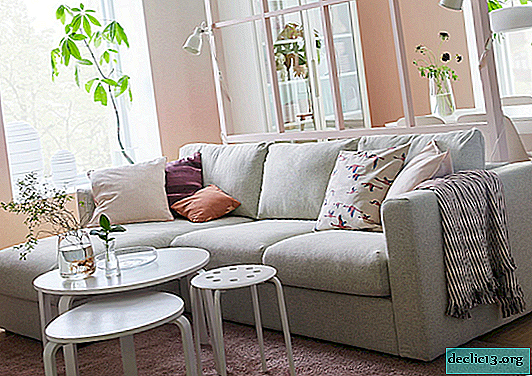A prickly, but beautiful resident of the windowsill is guernia! Home Care
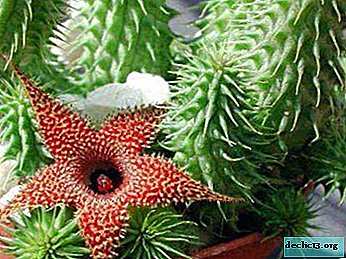
It is difficult to imagine a more beautiful, useful and organic way to revitalize your home than flood it with houseplants. In addition to the fact that the latter are extremely effective in purifying the air, they are also elegant, pleasing to the eye and exotic, due to which they bring original color to the interior.
One of these species will be discussed later in the article. This outlandish flower has several no less outlandish names, a very peculiar smell and an endless variety of colors.
Houseplant Description
Huernia (or guernia, guernia, guernia) in Latin Huernia is a whole genus of the Lastovnenvy family, consisting of stem succulents.
The representative of this genus was first described in 1810 South and East African researcher, scientist and botanist, Robert Brown. And the genus got its name in honor of Justin Herius, a Dutch missionary, the first collector of South African Cape plants. Therefore, the plant should have been called "Hernia," but other names came into use.
In its homeland, for its specific appearance and aroma, this flower was called the Devil's Tongue, Cadaveric Flower, Lily Voodoo and even the Snake Palm.
Botanical characteristics
 Huernia - perennial succulents. Their shoots are 22-30 centimeters branched at the base of the stem. Trunks are multifaceted (from four to seven faces), thick, bare, have gray-red or gray-green teeth.
Huernia - perennial succulents. Their shoots are 22-30 centimeters branched at the base of the stem. Trunks are multifaceted (from four to seven faces), thick, bare, have gray-red or gray-green teeth.
Flowers huernii five-lobed. Outlets have a funnel or bell shape. A flower can have both a matte color and a glossy color, or have a striped bright color.
Guernia blooms for a long period (from spring to autumn).
Guernia lives in nature in desert or semi-desert areas. The birthplace of this genus is South and East Africa. After 1810, representatives were also found on the Arabian Peninsula.
Nowadays, Huernia is a popular species of house plants.
Smell and appearance
Huernia stalks look traditionally for indoor succulents. They are low, fleshy, thick and seemingly quite neat, on some shoots there are sharp spiky outgrowths. The flowers are sprawling and bright, color and shape depends on the species.
Attention: smell is an extremely characteristic feature of Huernia. And the exclusivity lies in the fact that most representatives of this plant genus have the aroma of rotten meat. The smell is rather weak and is heard only with a strong approximation. Also, the smell intensifies with increasing temperature.Is it easy to grow?
Guernia is one of the most unpretentious plants in home breeding. Huernia is an extremely viable succulent. She does not need a lot of space for healthy growth and care is required exclusively nominal.
Huernii requires a wide low pot with drainage holes, substrate for succulents, moderate watering and western or southern plentiful lighting.
A variety of colors and their photos
Scientists have about 44 species of the genus Huernia, all of them are diverse, specific and non-identical. Some of these species will be written below.
Bearded - Barbata
The flower has four-pentahedral stems 3-6 cm long and spine-shaped processes. The flowers are bright yellow or brownish, on the leaves there are red blotches that form a pattern. The leaves of Huernia bearded are covered with fluff, which gave rise to the name of this variety.

Striped - Zebrina
The stems of this variety have 4 to 5 faces, their length is about 7 centimeters, and their diameter is up to 3 centimeters. Green shoots with marble patterns. The diameter of the flowers is about 4 centimeters, in the center is a thick shiny ring of the corresponding color. The petals are bent to the tips, their color is yellow-green or yellow with muddy-red horizontal stripes.

Hairy - Pillansii
Guernia hairy shoots have many faces 3 centimeters long and 2 in diameter. The outlet is noteworthy: spiral, with warts ending in thin hairs. The flowers have a bell-shaped shape, the petals are about a centimeter, bare, have yellowish spots and reddish papillae.

Large-fruited - Macrocarpa
Shoots of this variety have from 5 to 7 faces and sharp cloves on them. In diameter, the flower reaches two centimeters, on its surface there are brown dots.

Grungy - Aspera
In the rough type of houseplant, shoots are low to 6-8 centimeters, branching at the base. Some stems of this flower have brown teeth, rough to the touch. Flowers are grouped by 2-3 inflorescences, their color is reddish and deep brown inside.

Graceful - Concinna
The shoot reaches 5 cm in length, has five faces, long teeth and a glossy gray-green color with a reddish tint. Inflorescences are closer to the base of the stem 3-5 flowers. It looks really elegant.

Kenyan - Keniensis
The plant originates from a small area in Kenya. It has a stem up to 30 centimeters in length, with five ribs. Spikes are located on the shoots. The inflorescence includes 3-5 velvet crimson flowers. The diameter of the flower is about three centimeters, and the tips of the petal are triangular in shape.

Boleana - Boleana
The shoot grows up to 10 cm. The flowers are pale yellow, with burgundy camels. Boleana flowers have an atypical form for Huernia. The sepals are half fused into a wide tube. The petal itself has the shape of a star, and a diameter of up to two cm.

Prickly - Hystrix
The plant itself is small. In height, it reaches 12 centimeters, but up to 30 cm wide. Light green shoots have thick prongs growing upwards. The pedicel is about 7 centimeters long. Corollas are rounded, and the sepals are bent back and connected at the peduncle. Thus, it turns out something like a flower bagel attached to the tube.
On the surface of the flower there are growths that look like hairs up to 5 millimeters long. The flower has a burgundy and pale color, with papillae it seems striped.

Hanging - Pendula
The stems of this species of Guernia are up to one and a half meters long, which gave the name to the plant. Shoots in the form of a cylinder with a diameter of 9 cm. Stems are smooth and rounded. Flowers up to 2 cm in diameter. The bud is in the shape of a five-pointed star, burgundy red, inside the color is dark burgundy.

Primrose - Primulina
Representatives of this species are small in size, up to 8 centimeters in height and up to 2 cm in thickness, pentahedral, with denticles. Adults can reach 30 cm in diameter. The flower is bell-shaped, five-pointed, bent at the edges, yellow. Inside the flower has a reddish tint up to 3 cm in diameter.

Schneider - Schneideriana
The flower is known as the Red Dragon. The shoots are up to 10 cm long, 4-5-faced, green with spiky growths. The flower grows at the base of the plant. It is red or burgundy, the sepel is bell-shaped, a petal in the shape of a five-pointed star, bent at the end, with thin tips. Inside the flower is maroon.

Lying - Procumbens
The plant has a powerful multifaceted shoot, but the edges are rounded, with rare bud-shaped outgrowths. The flower opens when ripe and its five beige petals open. A raspberry-colored ring with a diameter of up to 2 cm is found inside. The pedicel is small, up to 8 cm.

Levy - Levyi
A plant of amazing appearance. Its shoots are small, up to 6-7 cm tall, tetrahedral, with denticles. The pedicel moves away from the base. The flower does not open completely, the shape of the sepals is bell-shaped, the petal has 4 long sharp endings and 5-6 short outgrowths. The flower is pale yellow, but the whole is dotted with a pattern of red dots. Inside the flower is dark red.

Licha - Leachei
Shoots are long, thin, with small kidney-shaped outgrowths, similar to vines. The pedicel is short and thin. The flower has the shape of a five-pointed star, yellow with a red dotted color and papillae like a pile inside. At the base of the flower is red. Flower diameter up to 2-2.5 cm.

Pickaxe - Kirkii
Shoots up to 5 centimeters, pentahedral. The flower grows at the base. Sepals open at the end of 2 centimeters, its diameter is about 1 cm. The petal has five thin processes located by a star. He himself is cream in color with red spots.

Doubtful - Confusa
Shoots have 4-5 faces, green-blue, long denticles with spines on the faces. The sepals are goblet, yellow, the tips of the petals are white, sharp, with a pattern in the form of red spots and stripes.

Short-billed - Brevirostris
This variety of Huernia has a height of up to 15 cm. The stems have 4 ribs, on the plane of each rib there are many denticles. The flowers are pale yellow or cream in color with a crimson pattern.

Home Care
Huernia is a fairly simple and unpretentious succulent plant.
- Lighting. To create favorable conditions, it is required to place the flower on a southern or eastern window. The plant needs a lot of light and a little direct sunlight.
- Temperature. The plant is a semi-desert climate, therefore it requires a warm content and temperature from 22 to 27 0C. But in the winter, it is better to contain Guernia at a temperature of about 16 0C.
- The location. The succulent is small-sized, so it can be located anywhere, it does not require a lot of space. But the site must be abundantly lit. Preferably southern or eastern lighting.
- Watering. Plants of the genus Huernia are drought tolerant. In spring and summer, he needs moderate watering. In autumn, watering needs to be reduced, and in winter, watering is rare (about once a month). Excess moisture is extremely undesirable, but Guernia tolerates drought well.
- Air humidity. Guernia does not need spraying and additional humidification. Dryness is quite acceptable for the genus Huernia.
- Top dressing. From late spring to September, Guernia blooms. During this period, bait may be appropriate. You can use fertilizers for cacti no more than once a month.
- The soil. For successful growth, a flower requires a small but wide pot and good drainage. Soil of approximate composition: 1 part of turf land, 1 part of leafy soil, 1 part of fine gravel. The acidity of the soil should be about 8, but not more.
- Pruning. Since the shoots of Huernia are quite specific and small, they do not need pruning. It can only be carried out with a transplant.
Breeding
Sometimes the owner of Guernia gets the task of obtaining new plant specimens. Problems with this usually do not arise. Huernia can be propagated by seeds or cuttings.
Seeds
 First, the seeds are sown in separate pots, in sandy soil or a special substrate for succulents.
First, the seeds are sown in separate pots, in sandy soil or a special substrate for succulents.
Young seeds can germinate in 3-4 weeks. The soil can be moistened moderately. Covering the containers with film or glass is not required.
After picking, the seeds are planted in separate pots.
Propagation by the seeds of Guernia does not have any special characteristics. This is the easiest way to propagate the plant, and the germination of seeds in Guernia is quite high.
Cuttings
- Cuttings are cut from adult shoots.
- The cuttings are dried, and then planted in a prepared substrate (coarse sand with peat crumb).
- Cuttings are rooted.
- After rooting, the cuttings are planted in small pots (about 7 cm). The soil for planting is described above.
Transfer
A transplant is recommended to be carried out annually in the spring if the succulent has outgrown its pot. It is recommended to transplant in a pot 1-2 cm wider than before.
reference: When transplanting, you can cut dried shoots or separate the cuttings for reproduction.Guernia is transplanted into the soil of the same composition where it grew before. Huernia transplant has no exceptional features.
Diseases and Pests
The main threat to Huernia is the mealybug. This insect causes irreparable harm to the plant. You can detect it by seeing a white coating on the surface of the plant.
 To combat this pest will help specialized tools that are sold in gardening stores.
To combat this pest will help specialized tools that are sold in gardening stores.
Also, do not forget about the threat of root and stem rot, which can occur on a plant. The appearance of rot is the ultimate diagnosis of a missing plant.
In order to prevent rot, it is necessary to observe moderate soil moisture. Following the rules of watering will protect your succulent from this scourge. Do not flood the plant heavily or expose it to frequent watering. It will not do any good.
Content difficulties
- Dark spots may appear on the stems of your pet. This is the result of "burning" in direct sunlight. But, if the plant lacks light, it will turn pale. Therefore, you must be careful about the lighting mode.
- During periods of flowering and vegetation, it is necessary to feed the plant and water it slightly more than usual. But in this, too, it is necessary to know the measure, for Hernia does not tolerate overmoistening or overfeeding. Overmoistening will lead to immediate decay of the root system.
- If you do not lower the temperature in winter, the plant will grow a few more shoots than usual, but will not bloom.
Conclusion
Huernia is a surprisingly diverse, exotic, beautiful and simple flower. This succulent is accustomed to harsh desert conditions, but will take root at home. Observing all the rules for the care of Guernia, you will receive an amazing and unique copy of the flora in your possession and complete disposal. But you should be careful about it.

